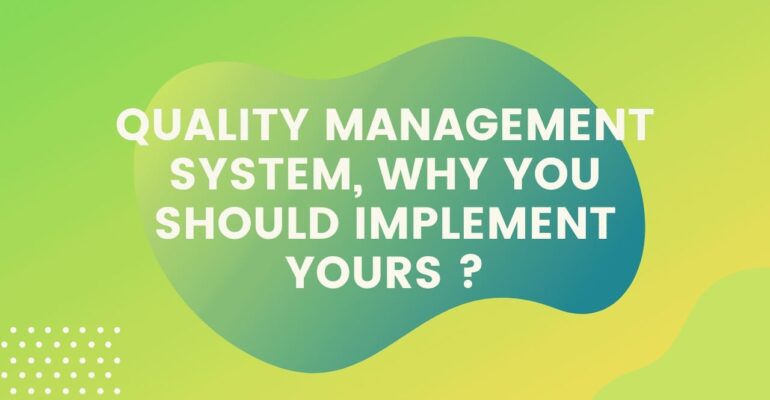Quality management system, why you should implement yours ?
Quality management system, why you should implement yours?
Let me ask you a quick question—how often do you find yourself juggling issues like inconsistent product quality, frustrated customers, or inefficient processes? If you’ve ever felt stuck trying to fix these problems, you’re not alone. That’s exactly where a Quality Management System, or QMS for short, can step in and save the day.
A QMS is more than just a fancy term; it’s a structured way to keep your business running smoothly, consistently delivering top-notch quality while improving efficiency. Think of it like your business’s GPS—it helps you navigate challenges, streamline your processes, and reach your goals faster.
If you’re wondering how to implement a Quality Management System, don’t worry—you’re in the right place. This guide is here to make the process easy to understand, whether you’re a small business owner just starting out or part of a larger company looking to improve operations.
By the end of this article, you’ll know exactly what a QMS is, why it’s so essential, and, most importantly, how to implement a Quality Management System that works for your business. Spoiler alert: it’s easier than you think! Let’s dive in.
What Is a Quality Management System (QMS)?
Alright, let’s take a step back and start with the basics. What exactly is a Quality Management System (QMS)? If the term sounds a bit technical, don’t worry—it’s actually pretty simple. A QMS is like a blueprint for how your business manages quality. It’s a set of processes, policies, and procedures that help ensure your products or services consistently meet customer expectations.
Think of it this way: if your business was a kitchen, your QMS would be the recipe book. It tells everyone what needs to happen, in what order, and how to do it so you always deliver something amazing. Whether it’s making sure your customers are happy, streamlining your operations, or keeping up with industry standards, a QMS helps you do it all in an organized, repeatable way.
Now, you might be wondering, “Why do I even need this? Can’t I just run my business the way I always have?” Well, here’s the thing: in today’s competitive world, delivering consistent quality isn’t just nice to have—it’s a necessity. Customers expect the best, and if you don’t deliver, they’ll happily take their business elsewhere. That’s why understanding how to implement a Quality Management System is so important. It’s the foundation that allows you to meet these expectations every single time.
A good QMS is flexible—it can be tailored to fit your unique business needs, whether you’re running a local bakery, a tech startup, or a global manufacturing company. And the best part? It doesn’t just improve the quality of your products or services; it also boosts efficiency, reduces waste, and makes life easier for everyone on your team.
By understanding how to implement a Quality Management System, you’re not just solving today’s problems; you’re setting your business up for long-term success. So, let’s keep going—because the more you learn about QMS, the more you’ll see why it’s the secret ingredient your business needs.
Why Should You Implement a Quality Management System?
Let’s talk about why implementing a Quality Management System (QMS) is such a game-changer for your business. I get it—change can feel like a big deal, especially if you’ve been doing things a certain way for years. But trust me, once you see the benefits, you’ll wonder how you ever managed without it.
First off, let’s address the obvious: consistency. Imagine if every product you made or service you delivered was flawless—every single time. A QMS makes that possible. By learning how to implement a Quality Management System, you’re building a framework that ensures consistency across the board, whether it’s in your processes, products, or customer experience. That’s not just great for your reputation—it’s also a surefire way to keep customers coming back.
But it doesn’t stop there. A QMS isn’t just about quality; it’s also about efficiency. How many times have you dealt with wasted resources, miscommunication, or processes that seem to take forever? By putting a QMS in place, you’ll streamline how your business operates. It’s like giving your workflows a major upgrade—fewer mistakes, faster results, and a team that knows exactly what they need to do and how to do it.
Another big reason to focus on how to implement a Quality Management System is compliance. Depending on your industry, you might need to meet certain regulatory or legal standards. A QMS helps you stay ahead of the game by making sure your processes are always in line with what’s required. No more scrambling during audits or worrying about penalties—your system will have you covered.
And let’s not forget the most important piece of the puzzle: your customers. At the end of the day, everything you do revolves around them. A QMS helps you deliver the kind of quality that builds trust and loyalty. When your customers know they can rely on you, they’ll stick around—and they’ll tell others about you too.
So, why should you care about how to implement a Quality Management System? Because it’s an investment in your business’s future. It’s not just about fixing problems or ticking boxes—it’s about creating a solid foundation that allows your business to grow, adapt, and thrive. If that sounds like something you want (and who wouldn’t?), then keep reading—we’re just getting started!
How to Implement a Quality Management System: A Step-by-Step Guide
Alright, now that we know why a Quality Management System (QMS) is such a big deal, let’s dive into the process of actually making it happen. If you’re feeling a bit overwhelmed, don’t worry—I promise it’s not as complicated as it might sound. Learning how to implement a Quality Management System is all about breaking it down into manageable steps and taking things one step at a time.
1. Assess Your Current Processes
The first step in implementing a QMS is to take a good, hard look at where you’re starting from. What’s working well in your business? Where are the bottlenecks? Are there recurring issues that keep popping up? This step is like doing a health check for your business—identifying strengths and areas that need improvement.
To make this easier, involve your team. They’re the ones in the trenches every day, so they’ll have valuable insights into what could be better. By starting here, you’ll have a clear idea of what your QMS needs to address.
2. Define Your Quality Goals
Next, it’s time to set some goals. What do you want your QMS to achieve? Maybe it’s reducing customer complaints, speeding up production, or meeting specific industry standards like ISO 9001. Whatever your goals are, make sure they’re clear and measurable. Knowing your endgame will make the entire process of how to implement a Quality Management System much smoother.
3. Choose the Right Framework
Here’s where things get a little technical (but not too much, I promise). Depending on your industry, there are different QMS frameworks you can follow. One of the most popular is ISO 9001, which is like the gold standard for quality management. It provides a structured approach and clear guidelines that can be customized to fit your business.
Not sure if ISO 9001 is the right fit for you? No problem—there are other options, too. The key is to choose a framework that aligns with your business needs and goals. This step will guide you as you work through the rest of the process.
4. Document Your Processes
This step might sound a little tedious, but it’s crucial. Documenting your processes is all about creating a roadmap for how things should be done in your business. Think of it as writing down your secret recipe for success so that everyone on your team knows exactly what to do and when to do it.
Don’t worry—you don’t have to reinvent the wheel. Start with the basics and build from there. A big part of how to implement a Quality Management System is creating documentation that’s easy to understand and follow.
5. Train Your Team
Here’s the truth: even the best QMS won’t work if your team doesn’t buy into it. That’s why training is such an important step. Take the time to explain why the QMS matters, how it will benefit everyone, and what their roles will be in making it a success.
When your team understands the “why” behind the QMS, they’ll be much more motivated to embrace it. And don’t forget to provide ongoing support—this isn’t a one-and-done kind of thing!
6. Implement Gradually
One of the biggest mistakes people make when learning how to implement a Quality Management System is trying to do everything all at once. Spoiler alert: that’s a recipe for stress and burnout! Instead, take a phased approach. Start with one department or process, make sure everything is running smoothly, and then expand from there.
By rolling out your QMS gradually, you’ll give yourself time to troubleshoot and make adjustments along the way. Plus, it’s much less overwhelming for everyone involved.
7. Monitor and Continuously Improve
Congratulations—you’ve implemented your QMS! But the journey doesn’t stop here. A successful QMS is all about continuous improvement. Regularly review your processes, track your progress toward your goals, and make tweaks as needed. This step ensures that your QMS stays effective and keeps delivering results.
By following these steps, you’ll not only learn how to implement a Quality Management System, but you’ll also set your business up for long-term success. It’s like building a solid foundation for a house—once it’s in place, everything else becomes so much easier. Ready to take the next step? Let’s do it!
Challenges You May Face When Implementing a Quality Management System (and How to Overcome Them)
So, you’re ready to learn how to implement a Quality Management System and start transforming your business—but let’s be real for a second. No big change comes without its challenges. The good news? You’re not alone, and every potential roadblock has a solution. Let’s look at some common obstacles businesses face when setting up a QMS and how you can tackle them like a pro.
1. Resistance to Change
Here’s the thing: people like their routines. Introducing a Quality Management System might feel like a big disruption to your team. They might worry it’s just “more paperwork” or fear it will complicate their jobs.
How to overcome it: Communication is key. Be upfront with your team about why the QMS matters and how it will benefit everyone, not just the business. For example, explain how streamlined processes can make their work easier and reduce stress. Don’t forget to involve them in the process early on—it’s much easier to get buy-in when people feel like they’re part of the solution.
2. Lack of Time and Resources
Let’s face it—running a business is already a juggling act. Adding “implement a QMS” to your to-do list might feel like a stretch, especially if you’re working with limited resources.
How to overcome it: Start small. A common misconception about how to implement a Quality Management System is that you need to do everything at once. Instead, focus on one area of your business where the impact will be most noticeable. You can always scale up later. And if resources are tight, consider investing in affordable QMS software or hiring a consultant to help you get started efficiently.
3. Difficulty Defining Processes
Sometimes, it can feel overwhelming to map out all your business processes, especially if they’ve never been formally documented before. Where do you even start?
How to overcome it: Keep it simple. Start by documenting the processes that are most critical to your business—like how you handle customer orders or manage inventory. Once those are in place, you can gradually add more. Remember, the goal of how to implement a Quality Management System isn’t to create endless documentation; it’s to create clarity and consistency.
4. Initial Costs
Another common concern is the cost of implementing a QMS. Whether it’s purchasing software, training employees, or hiring external help, the upfront investment can feel daunting.
How to overcome it: Think of it as an investment, not an expense. Yes, there are upfront costs, but the long-term benefits—like reduced waste, fewer mistakes, and happier customers—far outweigh them. Plus, there are scalable solutions for businesses of all sizes, so you can find an approach that fits your budget.
5. Keeping It Going
Once your QMS is in place, the next challenge is maintaining it. It’s easy to lose momentum after the initial excitement wears off, but a QMS only works if it’s consistently followed and improved.
How to overcome it: Build a culture of continuous improvement. Schedule regular reviews to see what’s working and what’s not, and make tweaks as needed. Celebrate wins—like meeting quality goals or reducing errors—to keep your team motivated. And remember, the essence of how to implement a Quality Management System is to create a system that grows and evolves with your business.
The Bottom Line
Challenges are a natural part of any new endeavor, and implementing a QMS is no different. But with the right mindset and approach, every obstacle becomes an opportunity to improve. By focusing on communication, starting small, and staying committed, you’ll not only learn how to implement a Quality Management System, but you’ll also create a framework that makes your business stronger, more efficient, and more successful in the long run.
So, don’t let the bumps in the road discourage you. You’ve got this—and your future, QMS-equipped self will thank you for taking the leap!
The Long-Term Benefits of a Quality Management System
So, we’ve talked about what a Quality Management System (QMS) is, why it’s important, and even tackled some of the challenges you might face along the way. But let’s get to the good stuff—the long-term benefits. Because here’s the truth: learning how to implement a Quality Management System is one of the smartest decisions you can make for your business. The rewards go far beyond fixing day-to-day issues. Let’s explore what a QMS can do for you in the big picture.
1. Consistent Quality, Every Time
Imagine if every product or service you delivered was the same high quality, no matter what. That’s exactly what a QMS helps you achieve. By following clear processes and standards, you’ll consistently meet (or even exceed) customer expectations.
This consistency isn’t just good for your reputation—it builds trust. Customers will know they can count on you, which means they’re more likely to stick around and recommend your business to others. And guess what? Understanding how to implement a Quality Management System is the first step to getting there.
2. Increased Efficiency and Reduced Waste
Let’s face it—waste is costly. Whether it’s time, materials, or effort, inefficiencies in your processes can add up fast. A QMS helps you streamline your operations by identifying areas where things are slipping through the cracks.
For example, you might discover a bottleneck in your production line or unnecessary steps in your customer service process. Once you fix these issues, you’ll save time, reduce costs, and create a smoother workflow. The result? A more productive team and a healthier bottom line.
3. Happier Employees
This one might surprise you, but implementing a QMS can actually boost employee morale. How? By giving your team clear guidelines, consistent processes, and the tools they need to succeed. When people know what’s expected of them and have systems that support their work, they feel more confident and less stressed.
Plus, involving your team in the process of how to implement a Quality Management System can make them feel valued and heard. When everyone is working toward the same goals, it creates a sense of unity and purpose that’s hard to beat.
4. Staying Ahead of the Competition
In today’s fast-paced world, businesses that adapt and improve are the ones that thrive. A QMS gives you a competitive edge by helping you deliver better quality, faster service, and greater value than your competitors. And since a QMS is all about continuous improvement, you’ll always be looking for ways to stay ahead.
Think about it—when you know how to implement a Quality Management System and make it work for your business, you’re not just surviving; you’re thriving in a way that sets you apart from the rest.
5. Long-Term Scalability
As your business grows, so do your challenges. What works for a small team of five might not cut it when you’ve expanded to 50 or 500. That’s where a QMS really shines. By establishing strong foundations now, you’ll have a system that can grow with you, ensuring that quality and efficiency remain consistent no matter how big you get.
6. Customer Loyalty and Positive Reviews
Happy customers are loyal customers. When you consistently deliver quality, your customers will notice—and they’ll reward you with their loyalty. They’re also more likely to leave glowing reviews and recommend your business to others. This ripple effect of satisfied customers is one of the most rewarding outcomes of learning how to implement a Quality Management System and doing it well.
The Takeaway
The benefits of a QMS aren’t just short-term fixes—they’re long-term game-changers. By understanding how to implement a Quality Management System, you’re creating a solid foundation for your business to grow, adapt, and thrive for years to come. It’s about more than just quality—it’s about building trust, efficiency, and a competitive edge that keeps you ahead of the game.
So, if you’re still on the fence about whether a QMS is worth it, think of it as an investment in your future. The time and effort you put in now will pay off in happier customers, smoother operations, and a business that’s built to last. Ready to get started? Let’s make it happen!
Conclusion: Take the First Step Toward Implementing Your Quality Management System
Now that we’ve covered the ins and outs of what a Quality Management System (QMS) is, why it’s essential, and how to implement a Quality Management System, let’s take a moment to reflect. Implementing a QMS might seem like a big task, but as we’ve explored together, it’s really about taking small, intentional steps toward building a stronger, more efficient, and more reliable business.
A QMS isn’t just about ticking boxes or following rules—it’s about creating a system that works for you. It’s about improving how your business runs, keeping your customers happy, and giving your team the tools they need to succeed. Whether you’re trying to boost consistency, reduce waste, or build trust with your customers, a QMS can help you get there.
If you’re still wondering how to implement a Quality Management System, here’s the best advice: just start. Begin by assessing where your business stands today and set clear, realistic goals. Remember, you don’t need to tackle everything at once. Start small, involve your team, and keep the focus on continuous improvement. Every little step brings you closer to a system that transforms your business for the better.
So, what’s next? Take that first step! Whether it’s researching frameworks like ISO 9001, documenting your processes, or having that first team discussion, action is what will move the needle. The journey might seem daunting at first, but the results—happier customers, a more efficient business, and long-term success—are absolutely worth it.
By now, you have the tools, knowledge, and confidence to get started. You’ve learned how to implement a Quality Management System, and now it’s time to put that knowledge into action. So, let’s make it happen—your future self (and your future business) will thank you!
Looking for More Resources on ISO 9001?
Looking for ISO 9001 Resources Tailored to Your Industry?
If this article helped clarify ISO 9001, take the next step with our industry-focused tools designed to simplify your certification journey:
📦 ISO 9001 Documentation Kits by Industry: Whether you’re in manufacturing, construction, consulting, or healthcare — we have complete, ready-to-use documentation tailored for your sector.
🎓 Online ISO 9001 Training: Learn how to implement ISO 9001 effectively with our easy-to-follow video lessons, real-world examples, and practical exercises.
📋 ISO 9001 Checklist: Download our step-by-step checklist to ensure your QMS meets all the 9001:2015 requirements from start to finish.
These resources are crafted to save you time, reduce stress, and help you achieve certification with confidence. Choose your industry and start now!

make ISO standards less intimidating and more approachable for everyone.
Whether it’s ISO 9001, ISO 22000, or the cosmetics-focused ISO 22716,
I’ve spent my career turning complex jargon into clear, actionable steps
that businesses can actually use. I’m not here to call myself an expert—I prefer “enthusiast” because I truly love what I do.
There’s something incredibly rewarding about helping people navigate food safety and quality management systems
in a way that feels simple, practical, and even enjoyable.
When I’m not writing about standards, you’ll probably find me playing Piano 🎹, connecting with people, or diving into my next big project💫.
- I’m an engineer specialized in the food and agricultural industry
- I have a Master’s in QHSE management and over 12 years of experience as a Quality Manager
- I’ve helped more than 15 companies implement ISO 9001, ISO 22000, ISO 22716, GMP, and other standards
- My clients include food producers, cosmetics manufacturers, laboratories, and service companies
- I believe quality systems should be simple, useful, and efficient
- Outside of work, I play piano and love learning something new every day
Let’s make ISO less about stress and more about success! 🙏






















